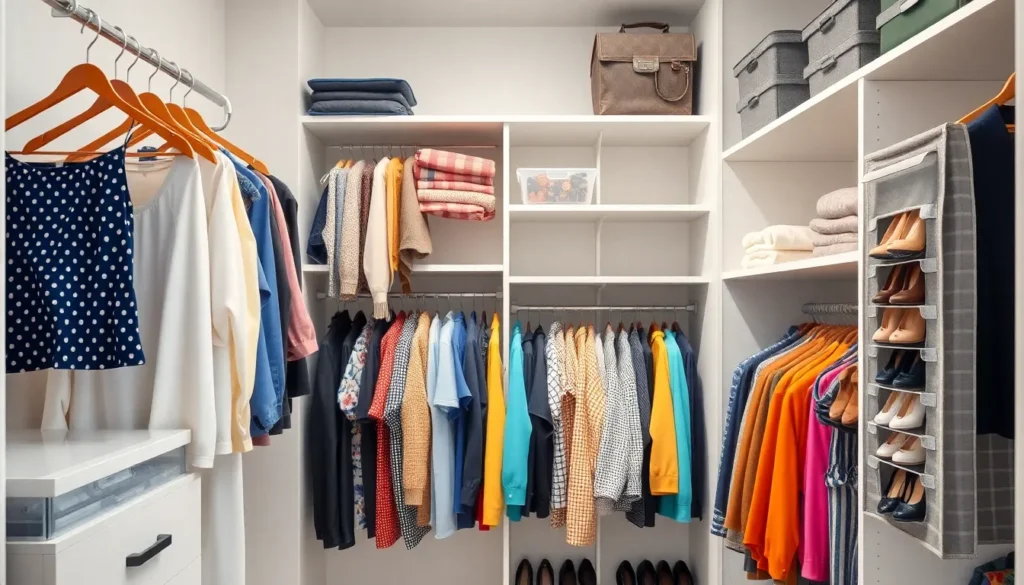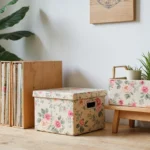We’ve all been there – staring into a chaotic closet wondering how we accumulated so much stuff and where anything actually belongs. Closet organization doesn’t have to be an overwhelming task that haunts your weekend plans. With the right strategies and a bit of creativity, we can transform even the most cluttered spaces into functional, aesthetically pleasing storage answers.
The secret lies in understanding that effective closet organization goes beyond simply hanging clothes and stacking shoes. It’s about creating systems that work with your lifestyle, maximizing every inch of available space, and maintaining order long-term. Whether you’re dealing with a walk-in closet, a tiny reach-in space, or something in between, the principles remain the same.
We’ll explore practical closet organization ideas that’ll help you reclaim your space and streamline your daily routine. From smart storage answers to space-saving hacks, these strategies will turn your closet into a well-organized sanctuary you’ll love opening every morning.
Maximize Vertical Space With Multi-Level Storage Solutions
Vertical storage transforms even the smallest closets into highly functional spaces. We’ll show you how to triple your storage capacity without expanding your closet’s footprint.
Install Double Hanging Rods for Short Items
Double hanging rods instantly double your hanging space for shirts, blouses, and pants. We recommend installing the top rod at 80 inches from the floor and the bottom rod at 40 inches to accommodate most garments comfortably.
Most closets waste valuable vertical space with a single rod positioned in the middle. Installing a second rod below creates two distinct zones for different clothing categories like work shirts on top and casual wear below.
Adjustable double rod systems cost between $15-40 and require no permanent installation. These tension rods work perfectly in rental properties where drilling isn’t allowed.
Add Stackable Shelf Dividers
Stackable shelf dividers create designated compartments for folded clothes, accessories, and shoes. We’ve found that vertical dividers prevent clothing piles from toppling over and maintain organization between washes.
Wire shelf dividers allow air circulation while keeping sweaters and t-shirts separated by color or season. Most dividers adjust from 12-24 inches wide to fit standard closet shelving.
Clear acrylic dividers offer a sleek appearance while providing visibility for quick item identification. These dividers stack up to 36 inches high and support up to 20 pounds per section.
Use Over-the-Door Organizers
Over-the-door organizers transform wasted door space into prime storage real estate for accessories, shoes, and small items. We recommend choosing organizers with clear pockets to quickly locate items without opening every compartment.
Shoe organizers with 24 pockets hold up to 12 pairs of flats or sneakers while keeping them dust-free and easily accessible. These organizers also work brilliantly for storing scarves, belts, and jewelry in separate compartments.
Heavy-duty over-the-door racks support up to 50 pounds and accommodate bulkier items like purses, jackets, and robes. Look for models with padded hooks to protect your door from scratches and dents.
Create Designated Zones for Different Clothing Categories
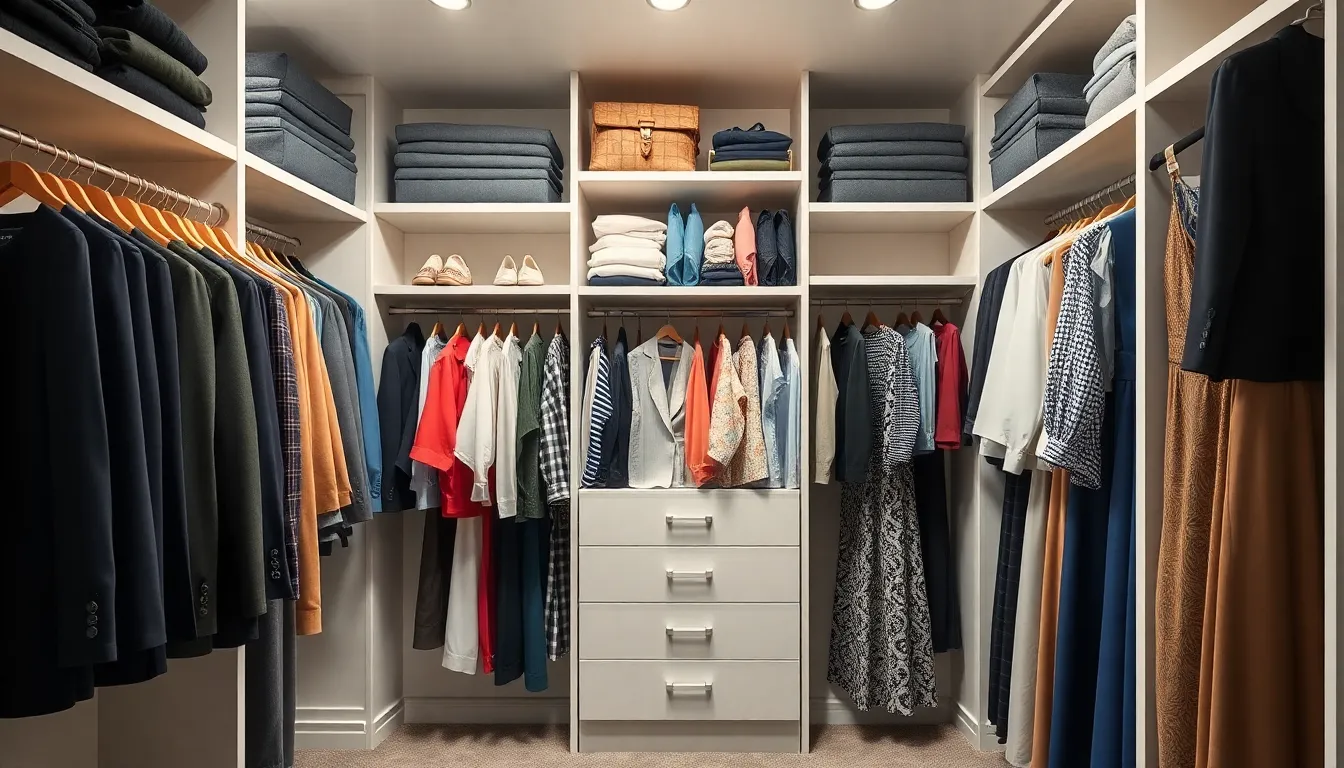
Building on smart storage answers, we’ll transform your closet efficiency by creating distinct zones for different clothing types. Professional organizers recommend this zoning approach to streamline daily routines and maximize storage potential.
Establish a Work Clothes Section
Position work attire at eye level for quick morning access. Place dress pants, blazers, button-down shirts, and professional accessories together in your closet’s most visible area. We recommend dedicating the center section or front-facing area to these essential pieces since you’ll reach for them frequently throughout the week.
Group professional accessories with corresponding outfits. Store ties, scarves, belts, and jewelry in nearby drawers or hanging organizers within your work zone. This strategic placement eliminates the morning scramble to find matching accessories and ensures your professional appearance stays polished.
Separate work shoes from casual footwear. Keep dress shoes, heels, and professional flats in a designated area within or adjacent to your work clothes section. Consider using a shoe rack or clear boxes at the bottom of this zone for easy identification and protection.
Design a Casual Wear Area
Allocate front or middle closet space for everyday essentials. Position jeans, t-shirts, sweatshirts, and loungewear in easily accessible areas since these items see daily rotation. Professional organizers suggest placing casual wear where you can grab items without stretching or searching through less-used pieces.
Organize casual tops by sleeve length and season. Separate short-sleeve shirts from long-sleeve options using shelf dividers or different hanging sections. This categorization makes outfit selection faster and helps you identify gaps in your wardrobe during seasonal transitions.
Dedicate drawer space for athletic and leisure wear. Create a exact drawer for workout clothes, yoga pants, and loungewear as demonstrated in professional closet layouts. Position this drawer adjacent to undergarments and socks for convenient access during your morning routine.
Set Up a Special Occasion Zone
Reserve upper shelves or rear sections for formal attire. Store evening dresses, suits, cocktail dresses, and seasonal formal wear in less accessible areas since these pieces aren’t needed daily. This placement protects delicate fabrics while keeping prime real estate available for frequently used items.
Protect special garments with appropriate storage answers. Use garment bags or breathable covers for formal dresses and suits to prevent dust accumulation and fabric damage. Professional organizers recommend cedar hangers for wool suits and padded hangers for delicate evening wear.
Create a seasonal rotation system within this zone. Store off-season formal wear in bins or garment bags on highest shelves, rotating items as needed throughout the year. Label containers clearly to identify contents without unpacking, making seasonal transitions effortless.
Implement Smart Shoe Storage Systems
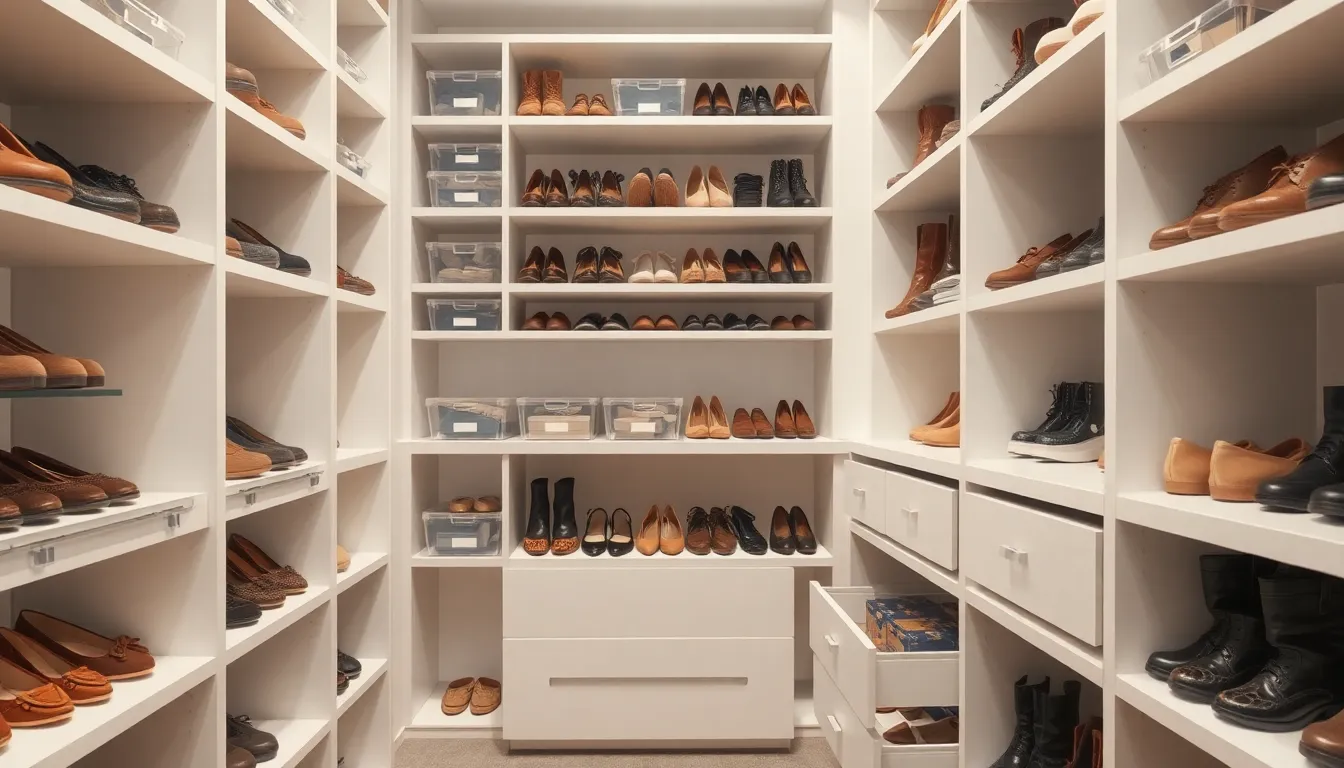
We’ll transform our shoe storage from chaotic piles into organized systems that save space and time. Smart shoe storage answers maximize our closet’s potential while keeping footwear easily accessible.
Install Slanted Shoe Shelves
Slanted shelves allow us to view each pair at a peek without lifting boxes or moving other shoes. We can easily identify and retrieve any shoe we need, making morning routines faster and more efficient. This design works particularly well in walk-in closets where we have adequate depth for the angled display.
Installing these shelves at different heights accommodates various shoe types from flats to boots. We’ll position frequently worn shoes at eye level for quick access. The slanted design prevents shoes from sliding off while creating an attractive visual display that transforms our closet into a boutique-like space.
Use Clear Shoe Boxes for Easy Identification
Clear storage boxes eliminate the guesswork of finding exact pairs buried in our closet. We can instantly see which shoes are inside each container without opening multiple boxes during busy mornings. This system works exceptionally well for seasonal shoes or special occasion footwear we don’t wear daily.
Stackable clear boxes maximize vertical space in our closets while protecting shoes from dust and damage. We’ll label each box for even faster identification, especially for similar-looking shoes like black pumps or brown boots. This method keeps our shoe collection organized while maintaining the pristine condition of expensive or delicate footwear.
Add Pull-Out Shoe Drawers
Pull-out drawers keep our shoes hidden while maintaining easy access through smooth sliding mechanisms. We can store multiple pairs per drawer while keeping the closet looking clean and uncluttered. This solution works perfectly for those who prefer a minimalist closet aesthetic without visible shoe storage.
These drawers accommodate different shoe heights through adjustable dividers that prevent pairs from mixing together. We’ll install them at comfortable heights to avoid bending or reaching too high. The closed storage protects our shoes from light exposure and dust while maximizing our closet’s overall storage capacity.
Optimize Small Spaces With Space-Saving Hangers
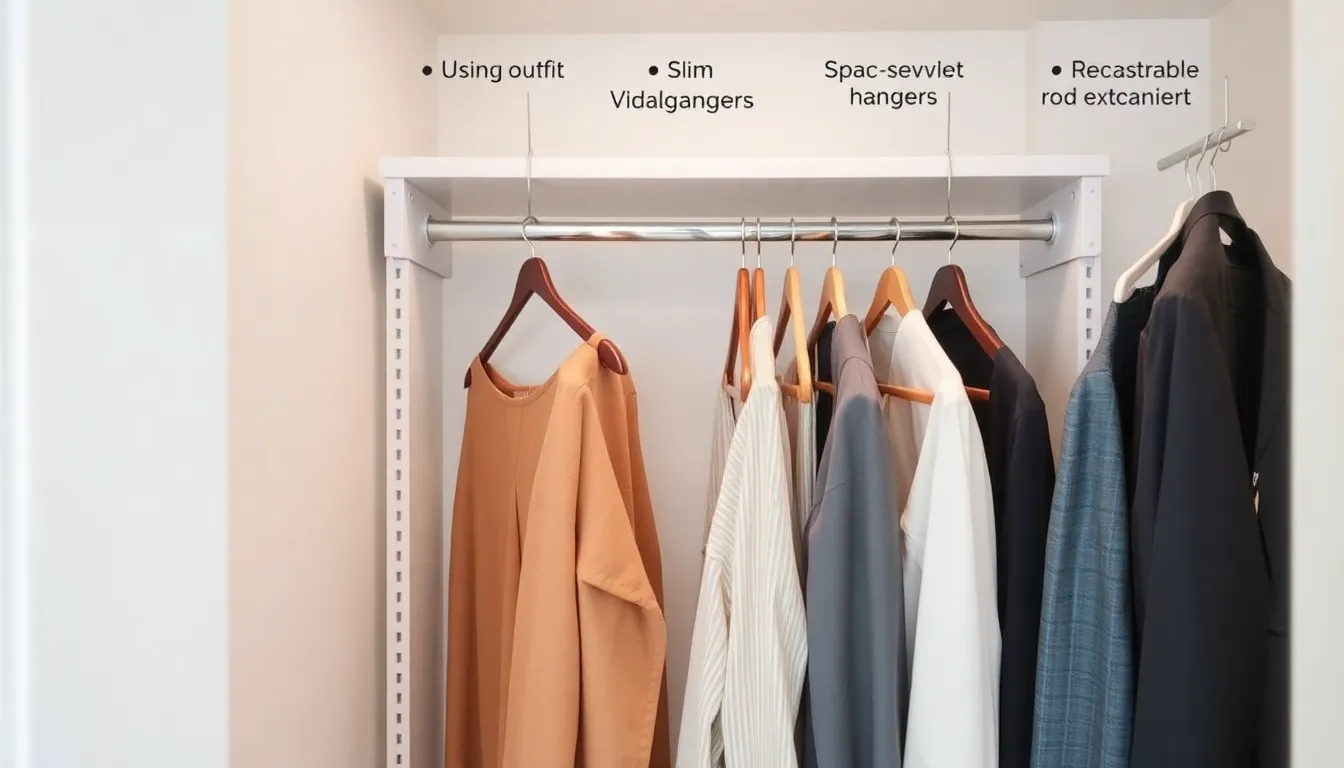
Small closets require strategic hanger choices to maximize every inch of available space. Specialized hangers can transform cramped storage areas into organized and efficient spaces.
Switch to Slim Velvet Hangers
Slim velvet hangers provide a non-slip surface that keeps clothes securely in place while taking up minimal space. Their sleek design allows for closer garment placement compared to bulky plastic or wire hangers. We recommend replacing traditional hangers with these space-efficient alternatives to free up valuable rod space immediately.
The velvet coating prevents delicate fabrics from slipping and maintains garment shape without stretching. These hangers work exceptionally well for shirts, blouses, and dresses in compact closets. Most retailers offer these hangers in neutral colors that create a cohesive, streamlined appearance throughout your closet.
Use Cascading Hangers for Multiple Items
Cascading hangers use a system of hooks or holes to stack hangers vertically on a single rod position. One hanger attaches to the closet rod while additional hangers connect below it, creating a vertical column for several garments. This method proves especially efficient for organizing pants, skirts, and jackets in constrained spaces.
These multifunctional hangers can hold up to five items in the space typically occupied by one garment. Major retailers stock various cascading hanger styles, including plastic and metal options designed for different clothing types. We suggest using these hangers for similar garments to maintain organization and easy access.
Install Retractable Valet Rods
Retractable valet rods are extendable hooks that attach temporarily to existing closet rods. They provide extra hanging space for outfits during preparation, ironing, or sorting tasks. These rods retract completely when not needed, avoiding permanent occupation of valuable closet space.
The temporary nature of valet rods makes them perfect for organizing daily outfits or separating items for exact occasions. They extend when you need additional hanging room and fold away seamlessly when the task is complete. These accessories prove particularly useful in small bedrooms, dorms, and apartments where every inch of closet space matters.
Utilize Underutilized Areas for Hidden Storage
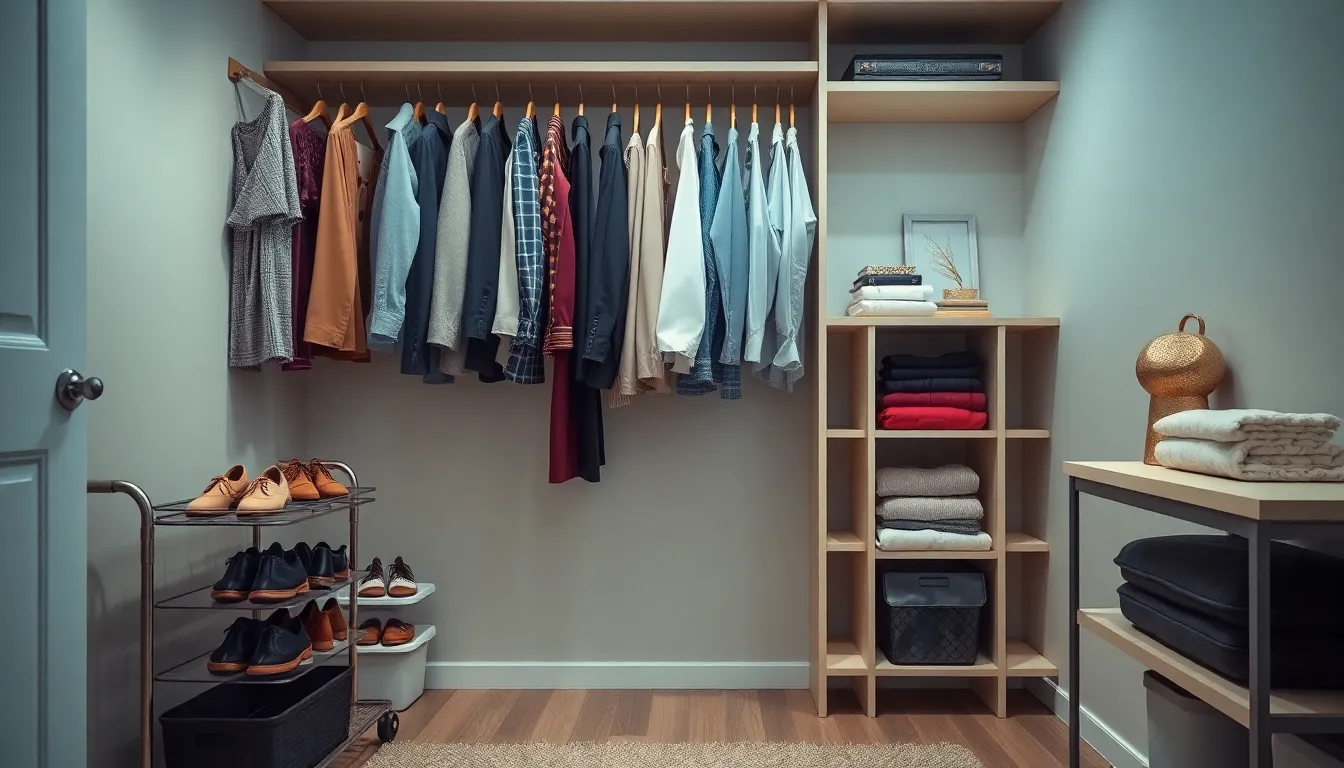
We’ve covered the main areas of closet organization, but now it’s time to discover those forgotten spaces that can dramatically increase your storage capacity. Hidden storage opportunities exist in nearly every closet, waiting to be transformed into functional answers.
Transform Floor Space With Rolling Carts
Rolling carts revolutionize how we use closet floor space by providing flexible, mobile storage that adapts to our changing needs. These wheeled units easily move aside when we need access to items stored at the back of the closet. Multiple tier designs and drawer configurations make them perfect for organizing shoes, accessories, or folded garments in a compact footprint.
Floor space often remains empty or gets cluttered with random items, but rolling storage units create intentional organization zones. We can designate exact carts for different categories like workout gear, seasonal accessories, or everyday essentials. When we need to reach something behind the cart, it simply rolls out of the way.
Add Storage Bins Under Hanging Clothes
Storage bins beneath hanging garments use the valuable vertical space that typically goes to waste between clothes and the floor. Clear containers allow us to quickly identify contents while maintaining a clean, organized appearance. Labeled baskets create designated homes for shoes, handbags, or folded items that don’t require hanging.
This approach transforms dead space into productive storage without requiring any installation or permanent changes. We can stack bins of different sizes to accommodate various items, from bulky sweaters to delicate accessories. Open crates work particularly well for frequently accessed items, while lidded bins protect seasonal or specialty pieces.
Install Corner Shelving Units
Corner shelving units maximize those awkward spaces where two walls meet, turning wasted areas into valuable storage real estate. Freestanding units offer flexibility for renters, while wall mounted options provide a more permanent solution for homeowners. Various sizes and configurations with integrated baskets or bins create customizable storage systems.
These specialized shelves excel at storing folded clothes, accessories, or small organizational containers that might otherwise clutter other areas. We can arrange items by frequency of use, keeping everyday essentials within easy reach while storing seasonal items on higher shelves. Corner units work especially well in closets with irregular layouts or challenging dimensions.
Organize Accessories With Specialized Storage Solutions
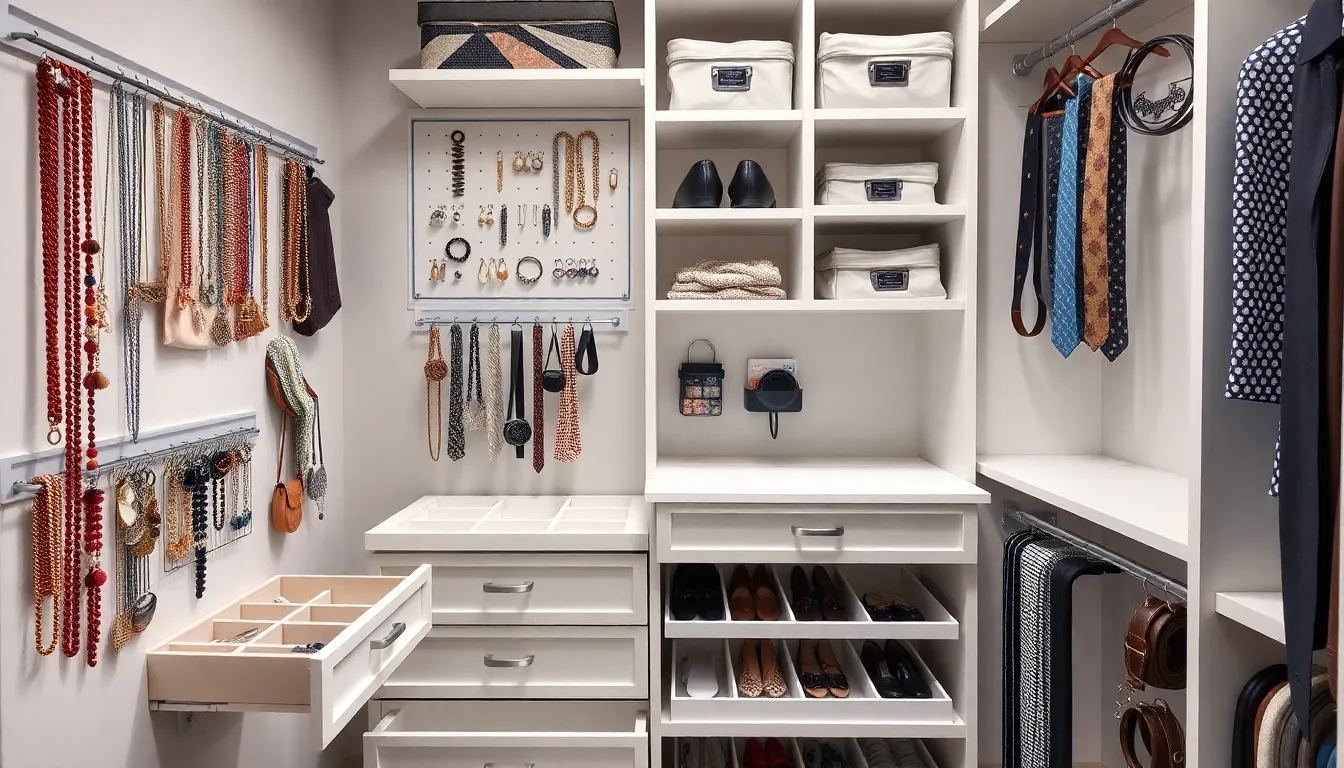
Transforming your accessory storage requires strategic planning and the right tools to keep everything visible and accessible. We’ll show you how specialized storage answers can turn chaotic accessory drawers into organized systems that save time and protect your valuable pieces.
Create a Jewelry Display Area
Setting up a dedicated jewelry display area helps prevent tangling and makes selecting pieces effortless. Wall-mounted organizers offer excellent visibility for necklaces, rings, and earrings while protecting them from damage that occurs when jewelry gets jumbled together in drawers.
Small frames with velcro strips inside drawers create custom compartments that keep jewelry pieces in place when drawers open and close. This simple DIY solution prevents necklaces from becoming twisted and ensures rings don’t roll around loose. Dedicated trays within drawers work exceptionally well for organizing different types of jewelry by category, making your morning routine faster and more efficient.
Use Drawer Dividers for Small Items
Drawer dividers transform cluttered spaces into organized zones where every small item has its designated place. We recommend creating custom dividers using loose frames and velcro strips to fit your exact drawer dimensions and storage needs.
Cutting foam core boards to match drawer sizes and attaching small containers creates storage pods that maximize both space and visibility for items like socks, hosiery, and undergarments. These custom answers prevent items from shifting around when you open and close drawers, maintaining the organized appearance you’ve worked to create.
DIY dividers offer important cost savings compared to store-bought alternatives while providing the exact configuration your accessories require. Affordable materials like cardboard, fabric, and basic hardware can create professional-looking results that enhance both function and visual appeal.
Install Belt and Tie Racks
Belt and tie racks eliminate tangling while keeping these accessories easily accessible and visible. Wall-mounted options work particularly well for maximizing closet space without sacrificing functionality or creating clutter on other surfaces.
Inside-door racks offer another excellent solution that utilizes previously wasted space behind closet doors. These installations keep belts and ties organized while maintaining easy access during your daily routine. Both DIY and store-bought versions can be installed quickly in any closet configuration.
Space-saving designs prevent the frustration of untangling belts and ties that often occurs when these items are stored in drawers or hung loosely on hooks. Proper rack installation enhances your overall closet organization by giving every accessory a exact home where it stays neat and ready to use.
Maintain Organization With Seasonal Rotation Strategies
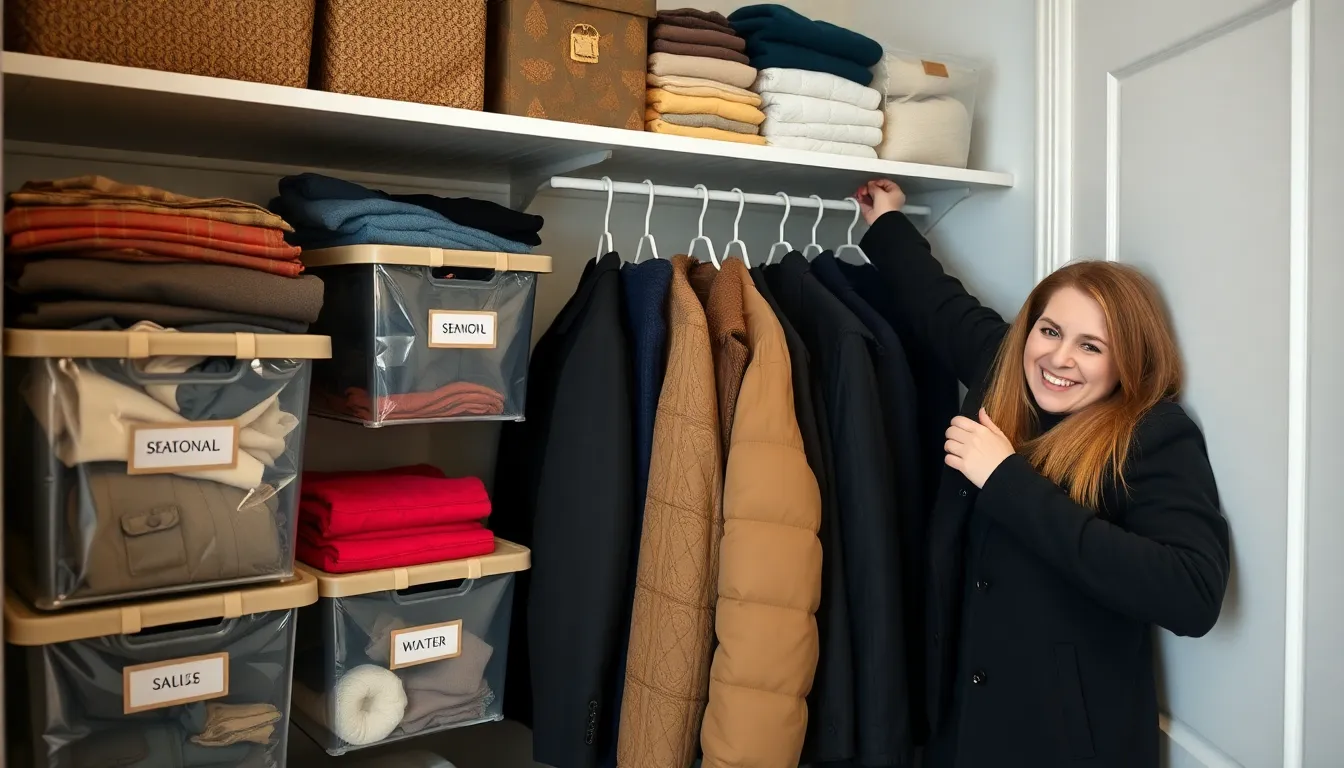
We can revolutionize our closet organization by implementing strategic seasonal rotation methods that keep only relevant items accessible while maximizing available space. These proven strategies help us maintain visual order and streamline our daily routines throughout the year.
Store Off-Season Items in Upper Areas
Utilizing high or less accessible spaces for off-season storage transforms our main closet area into a functional powerhouse. Top shelves naturally become the perfect home for winter coats during summer months, while under-shelf compartments house lightweight spring dresses throughout winter. We maximize our prime hanging space by relocating items we won’t need for months, keeping eye-level areas reserved for current season essentials.
Custom closet systems excel when we configure them modularly for seasonal changes. Upper storage bins accommodate heavy sweaters during warm weather, and overhead compartments store sandals when snow boots take priority. We create dedicated zones that shift purpose as temperatures change, allowing our closet layout to adapt seamlessly to our seasonal needs.
Use Vacuum-Sealed Bags for Bulky Items
Vacuum-sealed bags compress bulky winter coats and sweaters into compact, space-saving packages. These specialized storage answers reduce garment volume by up to 75%, transforming a stack of thick sweaters into a slim package that fits easily on high shelves. We protect our heaviest clothing items from dust, moths, and humidity while dramatically reducing their storage footprint.
Compression technology works exceptionally well for items we won’t access frequently. Down jackets compress to a fraction of their original size, and wool blankets become manageable packages that store efficiently in closet corners. We use these bags for seasonal bedding, creating additional space for current season clothing without sacrificing protection for our valuable winter gear.
Label Everything for Easy Identification
Clear, descriptive labels on bins and boxes eliminate guesswork during seasonal transitions. We categorize storage containers by exact seasons and clothing types, such as “Winter Accessories” or “Summer Formal Wear,” ensuring quick identification when weather patterns shift. These visual markers save precious time during busy morning routines and prevent unnecessary rummaging through multiple containers.
Strategic labeling systems reduce the time we spend searching for exact pieces during seasonal changes. Color-coded labels help us identify categories at a peek, while detailed descriptions specify contents like “lightweight cardigans” or “pool accessories.” We position labels on container fronts and tops for maximum visibility, creating an efficient retrieval system that maintains our closet’s organized appearance year-round.
Conclusion
We’ve covered many strategies that can transform any cluttered closet into an organized sanctuary. From maximizing vertical space with double hanging rods to creating designated zones for different clothing categories these methods work together to create lasting organization systems.
The key to successful closet organization lies in choosing answers that fit your exact lifestyle and space constraints. Whether you’re dealing with a walk-in closet or a compact wardrobe these practical approaches will help you maintain order while making your daily routines more efficient.
Remember that good organization isn’t about perfection—it’s about creating systems that work for you long-term. Start with one or two strategies that resonate most with your needs and gradually build from there. Your future self will thank you for the time invested in creating a functional organized space.
Frequently Asked Questions
What are the best ways to maximize vertical space in a small closet?
Install double hanging rods to create two levels for shorter items like shirts and pants. Use stackable shelf dividers to organize folded clothes into designated compartments. Add over-the-door organizers for shoes and small accessories. Consider corner shelving units to transform awkward spaces into functional storage areas.
How should I organize different clothing categories in my closet?
Create designated zones for each category. Place work clothes at eye level for easy access, group professional accessories with corresponding outfits. Design a casual wear section for everyday items, organizing tops by sleeve length and season. Use upper shelves or rear sections for special occasion wear.
What are the most effective shoe storage solutions?
Install slanted shoe shelves for better visibility and access. Use clear storage boxes for quick identification of different pairs. Consider pull-out shoe drawers for a clean, minimalist look. These solutions protect shoes from damage while maximizing floor space and organization.
How can space-saving hangers improve closet organization?
Switch to slim velvet hangers that take up minimal rod space while keeping clothes secure. Use cascading hangers to stack multiple items vertically, maximizing hanging capacity. Install retractable valet rods for temporary outfit preparation that can be easily stored when not needed.
What storage solutions work best for accessories?
Create a dedicated jewelry display area using wall-mounted organizers or DIY frames with velcro strips. Use drawer dividers for small items to maximize space and visibility. Install belt and tie racks on walls or inside doors to prevent tangling and improve accessibility.
How do I implement seasonal rotation in my closet?
Store off-season items in high or less accessible spaces like top shelves. Use vacuum-sealed bags for bulky items to save space and protect from dust. Label all storage containers clearly for easy identification during seasonal transitions. Keep only current season items easily accessible.
What are the best solutions for utilizing hidden storage areas?
Use rolling carts on closet floors for flexible, mobile storage that can be moved when needed. Place storage bins beneath hanging clothes to maximize vertical space. Install corner shelving units in awkward spaces for folded clothes and accessories, creating functional storage from forgotten areas.

